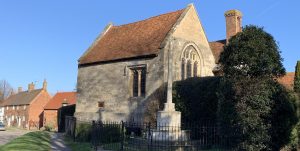
East Hendred is an ancient village, with a history which extends to the Iron Age and beyond.
To the South, the Parish crosses the ancient Ridgeway track (now a National Trail) and passes Scutchamer Knob, an Iron Age long barrow and the legendary burial mound of the Saxon King Cwichelm, who was reputed to have been killed by King Edwin of Northumbria in the 7th century. Scuthchamer Knob was also meeting point of the shire moot in the Middle Ages.
To the North, East Hendred is close to the village of Steventon and adjoins its sister village, West Hendred, on the West. Eastwards it borders the lands of Chilton and Harwell, close to the world famous international scientific centre – established on the site of a WW2 RAF air base and famous for its pioneering work on atomic energy, including Europe’s first nuclear reactor in 1946.
As East Hendred (Hennarith in 956 AD) has no through road today, its heart has survived to a great extent, with winding streets and lanes leading into field paths. There are two churches, the late 12th century St Augustine’s with its famous faceless clock and the Roman Catholic St Mary’s. There are also two modern schools (Catholic and Church of England), a sports ground and two public houses.
Known as a town, when it was an important centre for the wool and cloth trades before Henry VIII’s reign, this village has a history of unusual interest. Hendred House, Manor of the Arches, goes back even before permission to build its private St Amand’s Chapel was granted by the Pope in 1256 and the same family, the Eystons, have lived there since 1443. The little Chapel of Jesus of Bethlehem was built by the Carthusian monks of Sheen when they came to the nearby Kings Manor in the 15th Century.
For a tiny village, East Hendred has an amazing number of listed buildings (of which there are 73) and historical monuments. Still true today is James Edmund Vincent’s comment, made over a century ago in ‘Highways and Byways in Berkshire’, that ‘East Hendred is a village of no ordinary attraction’.
The village is unusual in having five manor houses, one of which, Hendred House (formally Arches Manor), has been held by a single family for over six hundred years. The Eyston family, heirs of the Arches, first acquired the property in the mid-15th century and remain ‘lords of the manor to this day’. The Eyston family were recusants, who remained Roman Catholic following the English Reformation and this has had a strong influence on the history and development of the village. The medieval chapel of Saint Amand, a private chapel attached to the manor house, remained in Catholic use during penal times and is still used for occasional services today. The family was also responsible for the building of St. Mary’s Church and the establishment of St Amand’s School during the 19th century. Notable members of the Eyston family include Charles Eyston, a 17th-century antiquarian, and Captain George Eyston, who held the world land speed record during the 1930s.
Further information can be found at East Hendred | East Hendred Heritage Trust | Hendred Museum.